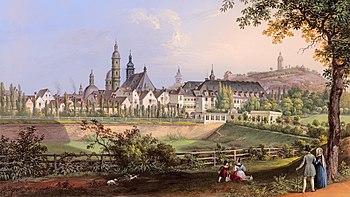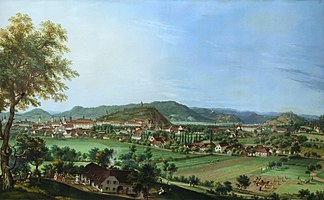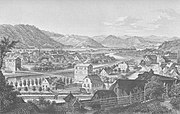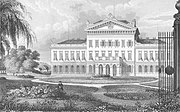Conrad cruiser
Conrad Kreuzer (also Konrad Kreutzer ; born December 8, 1810 in Graz , Austrian Empire ; † March 6, 1861 ibid) was an Austrian academic draftsman as well as landscape and vedute painter . With numerous drawings and paintings of his homeland, which he often made using the tempera technique, he is considered the most important "portraitist" of the city of Graz and the most important representative of Styrian Biedermeier . Above all, a series of steel engravings in the historical city guide by geography professor Gustav Schreiner brought Kreuzer lasting fame. His older brother Vincent was also a draftsman and landscape painter.
Life
Youth and education
Conrad Kreuzer was born in the Styrian capital Graz in 1810 , where he spent most of his life. His father was a minor civil servant named Peter. Only so much is known about his childhood and early youth that he felt connected to painting from an early age.
From 1828 Kreuzer attended the drawing academy in the Stubenberg Palace in his hometown. Although he was supposed to learn the basics for his later work there, he was not satisfied with the training and, like many others, tried to get a place at the Vienna Academy . Supported by a memorandum from his sponsor Albert Muchar , Kreuzer traveled to Vienna in 1830 to present Marie-Louise , Napoleon's widow , five landscape watercolors . In the same year, the Archduchess spent a holiday in the Villa Mandell in Graz and is therefore said to have been interested in the appearance of the city. However, the young artist came at an inopportune time and there was no reception, as was the prospect of an open space at the academy. As compensation for his work, he received 100 guilders .
Conrad then stayed - like his brother Vinzenz - at the drawing school until 1832 and studied under Josef August Stark (1782–1838). Unlike Josef Kuwasseg , for example , who learned a lot about ideal landscape design through his work at the Trenchensky lithographic institute in Vienna, the Kreuzer brothers stayed in Graz and acquired their painting skills in self-study. Ultimately, despite the unfavorable economic situation, both of them became well-known artists of their time.
Teaching
In order to earn extra income, Conrad Kreuzer also worked as a painting and drawing teacher in houses of the upper class. A testimony dated February 1, 1857 from a certain Prince of Württemberg certifies that the artist treated his pupils well:
“For five years, from 1846 up to and including 1850, Mr. Conrad Kreutzer in Gratz taught drawing, watercolors and oil grinding, partly to myself and partly to my children. He has a high degree of ability to express himself easily and to bring his students forward quickly through his teachings, while he is always trying to awaken the true sense of art and to bring about progress in a more noble sense. "
A court attorney and knight of the Imperial and Royal Franz Josef Order, Dr. Edler von Wasserfall, Kreuzer attested that between 1842 and 1848 he had given his four children lessons in "figure-heads-flowers and landscape painting both in oil and in watercolor with the best results". From the academic year 1853 on, he was a teacher at the Prince Bishop's College of Boys , the Carolinum-Augustinäum in Graz, where he gave lessons in figure and landscape drawing, watercolor and painting. The head of the institute and Canon Dr. theol. Johann Riedl praised Kreuzer's "skillful teaching method".
family
On July 6th, 1850, at the age of 40, he married Genoveva (née Rath) from Courts Bergen near Fürstenfeld . Two pictures that are now privately owned, a chapel painted in tempera on paper and a floral still life in watercolor on cardboard, are interpreted as bridal gifts. Vinzenz, the brother-in-law, portrayed Genoveva, whom he admired, who worked as a seamstress and died poor and penniless in Graz after the death of her husband. The marriage had two children. Son Konrad (1851–1934) became a typesetter and died childless in Feldbach , daughter Sofie (1855–1930) also died in Feldbach after "three days' sick leave of a heart attack and hardening of the arteries".
Conrad Kreuzer himself suffered in the last four years of his life - so it goes from the Parte his widow out - of multiple sclerosis . Despite illness, in 1857 he applied for a second apprenticeship in freehand drawing at the upper secondary school . The request is no longer self-made and the shaky signature is already marked by the nerve disease. His last painting, a landscape, dates from 1860. In March 1861, at the age of 50, he died in the poor and infirmary of the city. He was buried in the Steinfeldfriedhof.
plant
The artist's first works date from 1830. A watercolor cactus blossom stuck to cardboard with the artist's note “kubieyrt according to nature” already shows his deviation from the late classicist school tradition. By depicting nature rather than copying works from the past, Kreuzer did not follow the usual teaching method. He also painted his first cityscape, which was in the area of the former Dietrichstein bastion, that year. While Kreuzer never became an important oil painter as an autodidact in dealing with canvas and oil paint , he found the technique suitable for him in tempera painting . Compared to his oil paintings, his tempera paintings are characterized by a special luminosity of the colors and an even finer design of the details. He often produced the pictures in miniature-like designs with the help of magnifying glasses and looked for his motifs mostly in Graz and the surrounding area.
- Landscape Vedutas
Kreuzer placed particular emphasis on depicting the present with all of its technical achievements. Because he lived in the bridgehead building for a long time , of all the motifs he captured the Kaiser-Ferdinand- Kettenbrücke (at the location of today's Keplerbrücke ) the most frequently. His first of seven known views dates from the year of construction in 1836. Already in his early years, the painter developed away from the romantic landscape towards the vedute . In contrast to his first view of the city, in later works he abandons the restrictive view by framing elements and creates panorama-like overviews. Kreuzer's most important legacy is a series of 23 steel engravings that he made based on his own templates on behalf of Gustav Schreiner for his natural history-statistical-topographical city guide (1843). Although this work remained the only one that he carried out using a variety of techniques, it secured him recognition and lasting fame. Also known is a multi-part panorama series from two viewpoints on the Schloßberg , which was created in 1840/41. Another commissioned work, which provided for the Historical Association for Styria to depict all the castles and “strange places” in the country, was not completed - presumably for cost reasons. The late Conrad Kreuzer reinforced the holistic, compositional way of seeing and represented details more vividly. He also turned away from tempera painting and from 1850 produced almost exclusively oil paintings.
- Steel engravings for Schreiner's Grätz (1843)
Wilhelm Steinböck, director of the Graz City Museum , compiled a detailed list of works by the artist in advance of an exhibition in 1976. Of the total of 171 works that the art historian was able to track down, 98 are drawings, 53 tempera paintings, 17 oil paintings and three watercolors. Most of them were in private hands at the time of recording, the rest in the city museum, the Neue Galerie at the Landesmuseum Joanneum and in the Styrian State Archives .
reception
Conrad Kreuzer's complete oeuvre offers an almost complete picture of his hometown Graz and its immediate surroundings. Even if his name never achieved supraregional or even international importance, his numerous views made an important contribution to the history of Graz's city topography . His pictures, which were never lying or falsifying, brought him retrospectively terms such as “portraitist” or “the city's most excellent painterly interpreter”. According to the five views that he sent Marie-Louise of Austria, an Italian artist is said to have made frescoes in Modena Castle , but this was no longer verifiable in 1976. The original views of Eggenberg , Maria Trost , Maria Grün , St. Leonhard and the Villa Mandell are lost. There are two illustrations of the painter himself. In addition to a self-portrait from around 1845, a salt paper copy, probably from the 1850s , shows him in his profession with a drawing pad and pen.
The city of Graz named the Conrad-Kreuzer-Gasse in the 16th district of Straßgang after the artist. In 1976 and 2007, the Graz City Museum dedicated an exhibition to Conrad Kreuzer.
Works (selection)
Oil paintings
- Mountain landscape in Upper Styria . Oil on canvas, 39 × 49.5 cm, signed K. Kreuzer 835 .
- Upper Styrian landscape . Oil on canvas, inscription C. Kreuzer 1860 on the reverse.
- The Grabenvorstadt . Oil on canvas, 61 × 74 cm, signed C. Kreuzer .
- Mariatrost, a procession on the street in front . Oil on canvas, 61 × 77 cm, Neue Galerie ( Landesmuseum Joanneum ).
- Gmeingrube with the view of Trofaiach . Oil on canvas, 66 × 88 cm, signed C. Kreutzer 856 , Neue Galerie (Landesmuseum Joanneum).
- The dead woman . Oil on canvas, 95 × 72 cm, signed C. Kreutzer , dated 1856.
- St. Peter am Freienstein . Oil on canvas, 65 × 89 cm, signed C. Kreuzer 1857 , Neue Galerie (Landesmuseum Joanneum).
- Graz from the northwest, in the foreground the Villa Diana on Rosenberg . Oil on canvas, 61 × 77.3 cm, signed C. Kreuzer , Stadtmuseum Graz .
- Grundlsee . Oil on sheet metal, 25.4 × 32.2 cm, signed C. Kreuzer .
- Göß near Leoben . Oil on canvas, 75 × 96 cm, signed C. Kreuzer , dated 1858.
Tempera images
- Port fantasy . Tempera on paper, 36 × 46 cm, dated 1830, Neue Galerie (Landesmuseum Joanneum).
- The Acropolis of Athens . Tempera on paper, dated 1831, Neue Galerie (Landesmuseum Joanneum).
- Lustgarten on the Dietrichsteinbastei with a view of the mausoleum, cathedral, castle and Schloßberg . Tempera on paper, 27.8 × 35.6 cm, signed K. Kreuzer pinxit. 830 .
- Biedermeier garden in the Geidorfviertel . Tempera on paper, 66.2 × 103 cm, City Museum Graz, signed Conrad Kreuzer 1835 .
- Graz from the southeast, from the Ruckerlberg . Tempera on paper, 49.2 × 78.5 cm, signed and painted by C. Kreuzer academischer Mahler 836 , Stadtmuseum Graz.
- Chain Bridge of Graz and northwestern suburb . Tempera on paper, 64.5 × 89.7 cm, signed Taken and painted in 1836 by C. Kreuzer Academischer Mahler , Graz City Museum.
- Chapel . Tempera on paper, 9.3 × 14.3 cm, signed CK
- The Grabenvorstadt . Tempera on paper, 28.5 × 44 cm, signed C. Kreuzer .
- Graz, seen from Waltendorf . Tempera on paper, template for steel engraving in Schreiners Grätz , around 1840, Neue Galerie (Landesmuseum Joanneum).
- Main guard place . Tempera on paper, 12.9 × 20 cm, signed C. Kreuzer , template for steel engraving in Schreiners Grätz .
- Cathedral church . Tempera on paper, 13.7 × 20.5 cm, model for steel engraving in Schreiners Grätz , Graz City Museum.
- Mausoleum . Tempera on paper, 32 × 21 cm, template for steel engraving in Schreiners Grätz , Graz City Museum.
- Castle, mausoleum and parish church, seen from the Schloßberg . Part I of a panorama series from Schloßberg, tempera on paper, 29.9 × 44.5 cm, signed Conrad Kreuzer 841 .
- Graz to the southwest with the country house, the old town hall, the Radetzky Bridge and the Franciscan Church, in the foreground the Citizens' Bastion and the clock tower . Part II of a panorama series from Schloßberg, tempera on paper, 29.8 × 44.3 cm, signed Conrad Kreuzer 840 .
- View from the Schloßberg to the west of the Sack and the Murvorstadt . Part III of a panorama series from Schloßberg, tempera on paper.
- St. Peter city cemetery with the grave monuments of the Maria Theresa Order Knights General Frh. Von Langenau and General Frh. Von Zach . Tempera on paper, 37 × 55.8 cm, signed C. Kreuzer 840 , Neue Galerie (Landesmuseum Joanneum).
- Rosenberg from the southwest with Grabenstrasse . Tempera on paper, 29.6 × 43.7 cm, signed C. Kreuzer .
- Maria Grün, Kroisbach Church and Castle . Tempera on paper, 29.7 × 43.8 cm, signed Conrad Kreuzer 841 .
- Graz from the east, in the foreground the Mozart memorial . Tempera on paper, 75 × 100.5 cm, signed C. Kreuzer .
- Altaussee with a group of people . Tempera on paper, 20 × 29 cm, signed C. Kr.
- Styrian wine country area . Tempera on paper, 15 × 21.3 cm.
- Becoming and passing away: Vanitas representation with dragonflies, butterflies, snails, frogs, beetles, snakes and skulls . Tempera on paper, 27.5 × 44.7 cm, signed K. Kreuzer 833 .
Watercolors
- Self portrait . Watercolor on paper, 18.4 × 14 cm.
- Cactus flower . Watercolor on paper, glued to cardboard, 22.6 × 26.4 cm, signed K. Kreuzer .
- Flower still life with two pigeons . Watercolor on cardboard, 11 × 17.5 cm, signed C. Kreuzer .
drawings
- The old university . Pencil and pen, 10 × 15.5 cm, Graz City Museum.
- The mausoleum of Graz . Pencil drawing, 45.7 × 63.9 cm, Steiermärkisches Landesarchiv .
- Jakominiplatz . Pencil drawing, 10 × 15.5 cm, Graz City Museum.
- View from the Schloßberg to the cathedral church, seen from the Cerinischer Garten . Pen-and-ink drawing, watercolored, 27.5 × 44.5 cm, Styrian State Archives.
- View from the garden under the clock tower to the Palais Attems and Ursuline Church, in the middle distance the Murvorstadt . Pen drawing, washed, on tinted paper, 29.5 × 44.6 cm, signed Kreuzer , Steiermärkisches Landesarchiv.
- Tobelbad . Pencil drawing, 23.7 × 34.7 cm.
- View from Eggenberg over the city . Sepia drawing, 45.5 × 105 cm, Styrian State Archives.
- Connecting corridor between cathedral and castle to the west . Pencil drawing, washed, 28.3 × 30.4 cm, signed CK , Steiermärkisches Landesarchiv.
- The moat . Pen drawing, washed, on tinted paper, 26.7 × 44.4 cm, signed Kreuzer , dated 1838, Steiermärkisches Landesarchiv.
- Chain Bridge of Graz . Pencil drawing on tinted paper, 54.3 × 76.2 cm, Steiermärkisches Landesarchiv.
- The Gösting castle ruins . Pen drawing, washed, 39 × 48 cm, signed C. Kreuzer .
- View from the Schloßberg to the bell foundry house and the chain bridge . Pencil drawing, 66.4 × 102 cm, Styrian State Archives.
- Mariatrost . Pencil drawing, washed, on tinted paper, 38 × 48.7 cm, dated approx. 1860, Styrian State Archives.
- St. Leonhard . Pen drawing, washed, 42.5 × 59.3 cm, signed C. Kreuzer , Steiermärkisches Landesarchiv.
- City moat, behind mausoleum, cathedral, castle and castle hill . Pen drawing, washed, 26.5 × 44.5 cm, signed Kreuzer , Steiermärkisches Landesarchiv.
- Eggenberg Castle . Pen drawing, washed, 20.5 × 29 cm, signed C. Kreuzer .
- Eisenhammer at Feistritz near Peggau . Pencil drawing, 24.2 × 36.5 cm.
- Murvorstadtplatz . Pen and ink drawing, washed with sepia, 37.6 × 50 cm, signed and dated 1847, Neue Galerie (Landesmuseum Joanneum).
- Game on the Mur with the Schlossberg in the background . Ink and sepia drawing, 30.1 × 41.1 cm, signed C. Kreutzer , dated around 1840.
- Graz, seen from the Schloßberg to the south . Pencil drawing, 19 × 26 cm, Styrian State Archives.
- Alt-Pfannberg . Pen and ink drawing, washed, 33 × 44 cm, Styrian State Archives.
- Stübing Castle . Sepia drawing, 33 × 45 cm, Styrian State Archives.
- Waldstein Castle . Sepia drawing, 33 × 45 cm, Styrian State Archives.
- Waldstein ruins . Sepia drawing, 33 × 45 cm, Styrian State Archives.
- Basteigarten above the playground . Pencil drawing, 28.5 × 20.5 cm.
literature
- Cruiser, Konrad . In: Hans Vollmer (Hrsg.): General lexicon of fine artists from antiquity to the present . Founded by Ulrich Thieme and Felix Becker . tape 21 : Knip – Kruger . EA Seemann, Leipzig 1927.
- G. Gsodam: Kreuzer (Kreutzer), Konrad. In: Austrian Biographical Lexicon 1815–1950 (ÖBL). Volume 4, Verlag der Österreichischen Akademie der Wissenschaften, Vienna 1969, p. 268.
- Gustav Schreiner: Grätz. A natural-historical-statistical-topographical painting of this city and its surroundings. Verlag Franz Ferstl'sche Buchhandlung, Graz 1843, 638 pages (with 23 steel engravings by Conrad Kreuzer).
- Wilhelm Steinböck: Grazer landscape and vedute painter of the Biedermeier period - Conrad Kreuzer 1810–1861, Vinzenz Kreuzer 1809–1888. Series of publications by the Graz City Museum Volume I, Leykam , Graz / Vienna 1976, ISBN 3-7011-7064-9 , 160 pp.
- Primož Premzl (ed.): Zbirka ampelografskih upodobitev Vinzenza in Conrada Kreuzerja. Umetniški kabinet, Maribor 2001, ISBN 978-9616055178 , 268 pages (Slovenian, with 128 gouache pictures by Conrad and Vinzenz Kreuzers).
Web links
Individual evidence
- ↑ a b c d e f Wilhelm Steinböck: Grazer landscape and vedute painter of the Biedermeier period - Conrad Kreuzer 1810–1861, Vinzenz Kreuzer 1809–1888. Series of publications by the Graz City Museum Volume I, Leykam , Graz / Vienna 1976, ISBN 3-7011-7064-9 , p. 16.
- ↑ G. Gsodam: Kreuzer (Kreutzer), Konrad. In: Austrian Biographical Lexicon 1815–1950 (ÖBL). Volume 4, Verlag der Österreichischen Akademie der Wissenschaften, Vienna 1969, p. 268.
- ↑ a b c Wilhelm Steinböck, p. 17.
- ^ Wilhelm Steinböck, p. 18.
- ↑ a b Wilhelm Steinböck, p. 19.
- ↑ a b Wilhelm Steinböck, p. 20.
- ^ Conrad Kreuzer (Kreutzer). University of Graz , accessed on December 15, 2018 .
- ^ Wilhelm Steinböck, p. 26.
- ↑ a b Walter Titz: Graz (almost) in a 360-degree view . In: Kleine Zeitung , issue of February 23, 2007, p. 72.
- ↑ a b Pictures of a Lost City - The Graz vedute painters Conrad and Vinzenz Kreuzer . In: Kronen Zeitung , issue of February 13, 1977, pp. 34–35.
- ↑ Wilhelm Steinböck, p. 28.
- ↑ Wilhelm Steinböck, pp. 33–35.
- ^ Wilhelm Steinböck, p. 74.
- ↑ William Steinböck, pp 121-133.
| personal data | |
|---|---|
| SURNAME | Cruiser, Conrad |
| ALTERNATIVE NAMES | Kreutzer, Konrad (alternative spelling) |
| BRIEF DESCRIPTION | Austrian landscape and vedute painter |
| DATE OF BIRTH | December 8, 1810 |
| PLACE OF BIRTH | Graz |
| DATE OF DEATH | March 6, 1861 |
| Place of death | Graz |











